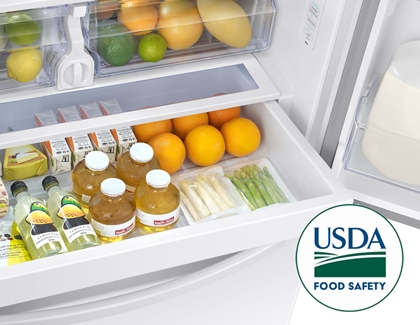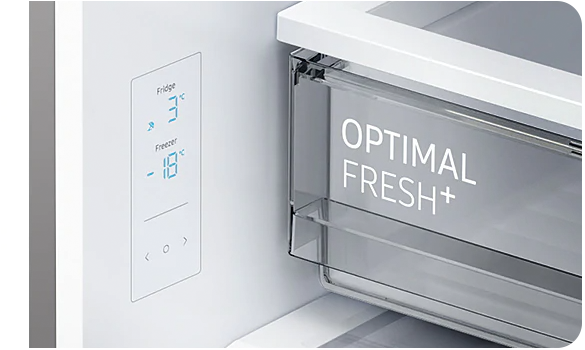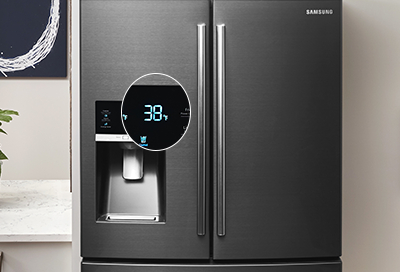A Samsung refrigerator should be set at 37°F (3°C) for the fridge and 0°F (-18°C) for the freezer. Ensuring your Samsung refrigerator operates at these recommended temperatures is crucial for optimal performance and food safety.
Modern households rely heavily on refrigerators to keep food fresh and safe for consumption. A properly set Samsung refrigerator is not only about maintaining freshness but also about running efficiently to reduce energy costs. Understanding these temperature settings can extend the lifespan of your appliance and the edibles inside.
Therefore, adjusting your Samsung refrigerator to the recommended settings is an easy step towards kitchen efficiency and food quality maintenance. Remember that seasonal changes or heavy usage may require occasional adjustments to maintain these ideal temperatures.
Setting The Scene: Samsung Refrigerators
Samsung has long been synonymous with innovation and reliability in home appliances. Its range of refrigerators is no exception, boasting features that combine efficiency with user-friendliness. Owners must understand the ideal temperature settings for maximized food freshness and energy conservation. Here, we’ll dive into the crucial aspects of Samsung refrigerators and the importance of maintaining the right temperature.
Key Features Of Modern Samsung Refrigerators
The latest Samsung refrigerators stand out thanks to their state-of-the-art features:
- Twin Cooling Plus technology maintains humidity and temperature levels.
- Flexible Storage options adapt space to your storage needs.
- Energy Efficiency is increased with advanced insulation and compressors.
- Smart Connectivity for monitoring and control via smartphones.
- Ice Master produces up to 10 pounds of ice per day.
Importance Of Proper Refrigerator Temperature
Ensuring the right temperature in your refrigerator is key to food safety and quality. Here’s why:
- Prevents bacterial growth and foodborne illnesses.
- Keeps food fresher longer, reducing waste.
- Optimizes the energy use of your appliance.
A Samsung refrigerator’s recommended temperature setting is between 37°F (3°C) and 40°F (4°C) for the fridge, and 0°F (-18°C) for the freezer.
Factory Settings Vs. Custom Preferences
Discover the ideal temperature settings for your Samsung refrigerator. Learn about the balance between factory settings and your own preferences. Tailor your fridge’s coldness to fit your lifestyle and keep food fresh.
Default Temperature Settings Explained
Your Samsung refrigerator comes with a set default temperature. This ensures your food stays fresh from the start. Most models have these presets:
- Refrigerator: 37°F (3°C)
- Freezer: 0°F (-18°C)
Manufacturers recommend these temperatures for energy efficiency and optimal performance.
Adjusting To Your Household Needs
Customizing temperatures in your fridge allows flexibility. Consider these factors:
| Factor | Adjustment Reason |
|---|---|
| Climate | Hotter areas might need cooler settings. |
| Load | A full fridge may require a lower temperature. |
| Food Types | Different foods might need specific temperatures. |
Adjust your Samsung’s settings easily through the control panel. Keep food at its prime by personalizing your fridge’s climate.
The Ideal Temperature Range
Knowing the perfect temperature setting for a Samsung refrigerator can make all the difference. It keeps your food fresh and your energy bills low. Let’s unveil the ideal range that experts recommend.
Recommended Settings For Food Preservation
The ideal fridge temperature for preserving food is between 37°F to 40°F (3°C to 4°C). For the freezer, aim for 0°F (-18°C). These settings ensure food safety while maximizing freshness and taste.
- Fridge: 37°F to 40°F (3°C to 4°C)
- Freezer: 0°F (-18°C)
| Compartment | Temperature |
|---|---|
| Refrigerator | 37°F to 40°F (3°C to 4°C) |
| Freezer | 0°F (-18°C) |
These settings can prevent bacteria growth and avoid freezer burn on frozen goods.
Understanding The Temperature Scale
Your Samsung fridge might have a digital scale ranging from 1 to 7, where each number corresponds to specific temperatures.
- Level 1: Warmest setting
- Level 7: Coldest setting
Adjusting to the middle range, typically level 3 or 4, gives you the optimal cooling effect without excessive energy use. Keep in mind, the right setting might vary depending on model versions and environmental factors.
Remember to check your fridge’s manual for specifics, as user interfaces can differ. It ensures your food’s safety and your fridge’s performance.

Credit: www.samsung.com
Balancing Energy Efficiency And Freshness
Setting the right temperature on your Samsung refrigerator strikes a key balance. It ensures your food stays fresh. It also saves energy. Finding that sweet spot helps reduce bills and waste. Let’s explore how to adjust the fridge to perfect both energy efficiency and freshness.
Energy Saving Tips For Refrigerator Use
Follow these simple tips to lower energy use:
- Check Seals: Ensure door seals are tight. Prevent cold air from escaping.
- Leave Space: Avoid overpacking. Ensure air circulates properly.
- Set Right: Opt for the manufacturer-recommended settings, usually between 37°F and 40°F for fridges.
- Keep it Full: A full fridge maintains cold better. But don’t overfill.
- Allow Leftovers to Cool: Wait before storing warm food. It lowers the extra load on the fridge.
- Clean Coils: Dust-free coils at the back improve efficiency.
- Consider Size: Choose a fridge size that suits your needs. Bigger isn’t always better.
How Temperature Affects Food Quality
Temperature plays a crucial role in keeping food fresh. But what’s the best setting?
| Temperature Range | Effect on Food |
|---|---|
| Below 32°F (0°C) | Can freeze and damage food |
| 32°F to 40°F (0°C to 4°C) | Recommended for fresh produce |
| Above 40°F (4°C) | Risks faster spoilage and bacteria growth |
Most Samsung refrigerators come preset at 37°F. It’s optimal for a variety of foods. Regularly check and adjust the setting to ensure maximum freshness.
Temperature Variations: Different Food Types
Knowing the right temperature settings for your Samsung refrigerator helps keep food fresh. Different types of food require specific temperatures to maintain freshness and safety. Understanding these variations is key to optimize their shelf life and flavor.
Meat, Dairy, And Produce Sections
Foods are diverse, and the conditions they need can differ drastically.
Meat Section
- Meats need chilly, consistent conditions.
- Set the meat section near 32°F (0°C) to prevent spoilage.
- Avoid warmer zones which can lead to bacterial growth.
Dairy Section
- Dairy thrives around 40°F (4°C).
- This range keeps milk and cheese fresh without freezing.
Produce Section
Fruits and vegetables can be delicate and need warmer temperatures than meat and dairy.
- The crisper drawer, typically above 40°F (4°C), is optimal.
- For firmer produce, a slightly colder setting preserves firmness.
Specialized Compartments For Specific Foods
Your Samsung refrigerator may come with specialized compartments for specific foods.
| Compartment | Temperature (°F) | Temperature (°C) | Food Types |
|---|---|---|---|
| Chef Pantry | 30 | -1 | Meats, Fish |
| CoolSelect Pantry™ | 37 | 3 | Delicatessen |
| Fresh Drawer | 38 | 3 | Produce |
Make sure to adjust settings according to what you store in each compartment. Proper use of these compartments helps extend food life and maintains taste.

Credit: www.samsung.com
Advanced Features In Samsung Models
The advanced features in Samsung refrigerator models offer an unmatched fusion of sophistication and efficiency. These high-tech refrigerators come equipped with smart functionalities. They make sure your food stays fresh at the optimal temperature. It’s crucial to set your Samsung refrigerator to the right temperature for effective preservation. Samsung models come with features that not only maintain the correct temperature. They also provide flexibility and convenience through innovative technology.
Innovations In Temperature Control
Samsung refrigerators boast state-of-the-art temperature control systems. These systems provide precise cooling. Different sections of the fridge can have different temperatures. This is perfect for different types of food. A common setting for the fridge is 3°C (37°F). The freezer typically sets at -19°C (-2°F). Samsung offers:
- Twin Cooling Plus™ – It separates airflow between the fridge and freezer. This maintains high humidity. It keeps fruits and veggies crisp for longer.
- Metal Cooling – The metal plate helps maintain cool air. It also quickly restores the right temperature after the door opens.
- FlexZone™ – This is a versatile bottom-right door. It can switch between a fridge or a freezer. Its temperature settings adapt to your needs.
Utilizing Smart Functions For Optimization
With smart functions, Samsung takes refrigeration to the next level. These functions include:
- Wi-Fi connectivity – Control and monitor temperature from your smartphone.
- SmartThings – Get alerts. They tell when to close the fridge door or if a temperature change happens.
- Family Hub™ – A touch screen gives control over the fridge. Create shopping lists, stream music, or manage family calendars.
Such features not only maintain the ideal temperature. They also adapt to usage patterns and lifestyle habits. For instance, going on vacation mode can save energy with minimal cooling. Using these smart features keeps your food at its best.
Troubleshooting Common Temperature Issues
Troubleshooting common temperature issues with your Samsung refrigerator ensures its optimal performance. Keeping food fresh and safe relies heavily on maintaining the right temperature. Discover how to address fluctuations and malfunctions that could affect your fridge’s efficiency.
When To Adjust The Settings
The ideal temperature for a Samsung refrigerator is 37°F (3°C) for the fridge and 0°F (-18°C) for the freezer. If you notice the following signs, it’s time to adjust the settings:
- Condensation inside the fridge
- Foods freezing in the refrigerator compartment
- Ice cream too soft in the freezer
- Perishables spoiling quickly
Use the control panel to adjust the temperature settings easily.
Dealing With Fluctuations And Malfunctions
Temperature instability can be a sign of malfunction. To deal with such issues:
- Inspect the seals for any signs of wear or damage.
- Ensure the fridge isn’t overloaded, as this blocks air circulation.
- Check the thermostat settings.
- If problems persist, consider a professional inspection.
| Problem | Possible Cause | Solution |
|---|---|---|
| Warm Fridge | Blocked vents or dirty coils | Clean and clear obstruction |
| Freezer Frost | Humid environment | Check the door seal integrity |
| Constant Running | High room temperature | Modify the surroundings |
Reset the fridge by unplugging it for a minute if you encounter consistent issues. This action can often resolve minor electronic glitches.
Maintaining Your Refrigerator For Consistent Performance
Your Samsung refrigerator is the heart of your kitchen. Keeping it at the right temperature is crucial. The ideal setting for Samsung refrigerators is 3°C (37°F) for the fridge and -18°C (0°F) for the freezer. But temperature is just part of the story. To ensure consistent performance, regular upkeep is essential. Let’s dive into the world of refrigerator maintenance.
Regular Cleaning And Maintenance Schedule
Sticking to a cleaning and maintenance schedule keeps your fridge running smoothly. Here’s what you can do:
- Clean the interior monthly with a gentle detergent.
- Wipe spills immediately to prevent odors and stains.
- Check the door seals and clean them to ensure they are tight.
- Defrost the freezer section if it’s not frost-free, as ice buildup affects performance.
Remember to pull the fridge away from the wall and dust the coils every six months. Blocked coils can lead to overheating and higher energy bills.
When To Seek Professional Assistance
Sometimes, issues need a professional’s touch. Look for these signs:
- Unusual noise, which could mean a fan or motor issue.
- Poor cooling, suggesting a problem with the thermostat or coolant.
- Excessive frost buildup in a frost-free model.
- Water leakage inside or outside the refrigerator.
If you notice any of these issues, contact certified Samsung service personnel. Delaying could lead to higher repair costs or even spoilage of your food.

Credit: www.samsung.com
Frequently Asked Questions Of What Temperature Should A Samsung Refrigerator Be Set At
What Temperature Should My Samsung French Door Refrigerator Be Set At?
Your Samsung French door refrigerator should be set at 37°F for the fridge and 0°F for the freezer.
What Is The Ideal Setting For A Samsung Fridge Freezer?
The ideal setting for a Samsung fridge freezer is 37°F (3°C) for the fridge and 0°F (-18°C) for the freezer.
How Do I Reset The Temperature On My Samsung Refrigerator?
To reset the temperature on your Samsung refrigerator, press the Fridge button to set your desired temperature. Wait for the temperature to adjust, which may take up to 24 hours. Always refer to your user manual for model-specific instructions.
Should Fridge Be At 1 Or 5?
Fridge temperatures should be set at 3 to 4 for optimal food preservation. Setting 1 is too warm, while 5 may be unnecessarily cold, leading to excess energy consumption and possibly freezing food.
Conclusion
Setting your Samsung refrigerator to the optimal temperature ensures food safety and energy efficiency. Aim for 37°F (3°C) in the fridge and 0°F (-18°C) in the freezer for best results. Regular checks and adjustments keep your appliances running smoothly, safeguarding your groceries and wallet alike.
Remember, a stable temperature maintains freshness and reduces waste. Keep it cool, and your Samsung refrigerator will take care of the rest.

